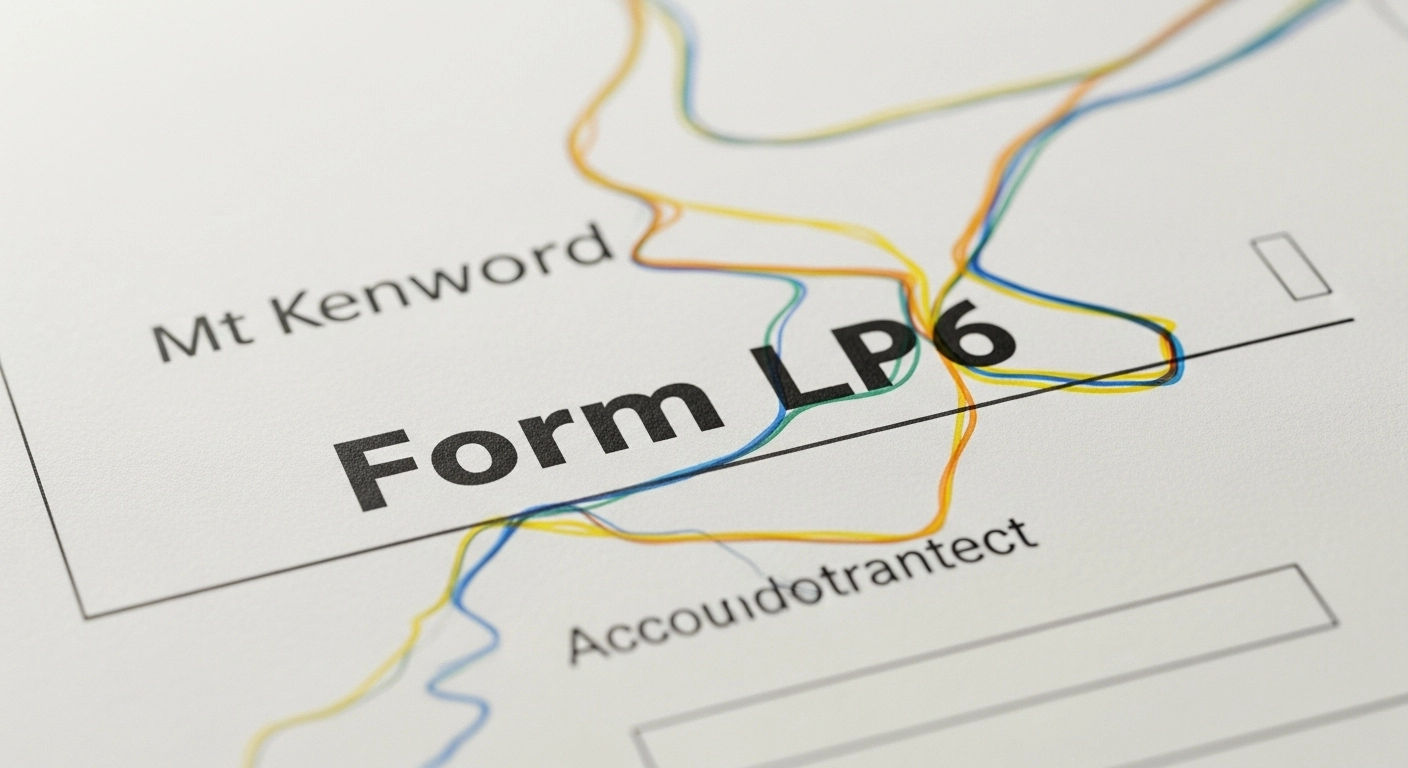What Is Form LP6
Form LP6 is an obligatory report that Texas limited partnerships must submit annually to the Texas Secretary of State for maintaining legal good standing for partnership formation. Form LP6 is the annual report required by the Texas Secretary of State for all active and foreign limited partnerships operating in Texas. This is a statutory compliance requirement under the Limited Partnerships Act 1907, ensuring that the information about partnerships is updated and accurate on the public register. The statutory filing requirement fee is crucial to maintaining the legal status of your partnership and avoiding default penalties.
The payment for Form LP6 indeed covers the basic processes of your annual return, which include filing at Companies House, maintaining the intricate systems that regulate Limited Partnerships, and the UK limited partnership framework. If payment and filing are postponed for an extended period, one risks facing severe penalties and potential dissolution proceedings.
What Are the Different Types of Form LP6 Filings?
There are the following types of form LP6:
Standard Annual Return Form LP6
In most cases, the standard Form LP6 applies to UK limited partnerships that conduct business activities. This form contains essential partnership information, including the partners’ names, registered addresses, and the nature of their business activities. Like all standard filings, it incurs the £36 fee and must be submitted within the 28 days following the partnership’s registration anniversary.
Domestic limited partnerships and foreign partnerships registered to operate in the UK are both covered by the Standard Form LP6. The criteria for filing remain the same, irrespective of the size of the partnership or the complexity of the business.
Dormant Partnership Form LP6
Even partnerships that have gone dormant and are not actively trading are still obligated to file Form LP6 annually. The £36 fee and submission timelines are the same as for active partnerships. Statutory filing obligations must be met irrespective of active or dormant status. Partnerships must indicate dormant
Status on the Form LP6 submission
All processes and payments remain the same as active partnerships. Partnerships, even in dormant status, are fully registered and compliant with all obligations. Each series must keep separate compliance records and filing calendars, as each is treated as a distinct legal entity for regulatory purposes. Payment processing for several series within a single entity can still be streamlined through a vendor clearinghouse or consolidated filing service.
Private Fund Limited Partnership (PFLP) Form LP6
Private Limited Fund Partnerships are treated as partnerships for Form LP6 filing purposes and are thus exempt from the enhanced legal framework because of the lack of Form LP6. The fee is the same as £36, and the payment methods and processing are the same as for PFLP structures. PFLP filings are subject to more stringent regulatory requirements concerning the fund’s activities and investment structures; the fundamental payment requirements are similar to those of other types of partnerships.
What Are the Key Benefits of Timely Form LP6 Payment Submission?
Preservation of Legal Standing
Compliance with timely Form LP6 payment effectively preserves the partnership’s legal standing with Companies House, ensuring recognition as a registered entity. This legal status safeguards the partnership structure while maintaining the limited liability shield for the partners against operational debts. Preservation of legal standing permits ongoing business activities, enforcement of legal contracts, and maintenance of banking relationships. Partnerships without a current filing status risk operational limitations and may face dissolution proceedings.
Avoiding Accruing Penalty Fees
Paying promptly eliminates the risk of incurring automatic penalties, which increase the annual compliance fee from £36 to upwards of £1,500. Preserving these penalties translates to significant cost avoidance, which translates directly to partnership profitability. Paying any fees as early as possible creates maximum cost efficiency while also proving effective partnership management for stakeholders and regulators.
Protecting Professional Image
Investors, creditors, and business associates view the current filing status as prudent management and compliance with regulatory frameworks, thereby enhancing business reputation. This credibility can be crucial for financing, attracting investment, or expanding business partnerships. Banks and financial institutions routinely check entity compliance status as a prerequisite for opening an account or issuing a credit facility.
| Payment Timing | Total Cost | Savings vs Late Filing |
|---|---|---|
| On Time (£36) | £36 | £1,500 saved vs maximum penalty |
| 1 Month Late | £186 | £1,350 saved vs maximum penalty |
| 3 Months Late | £786 | £750 saved vs maximum penalty |
| 6+ Months Late | £1,536 | Maximum penalty incurred |
Current Form LP6 filing offers instant confirmation for partnership compliance and operational competence for partnership structures, therefore accelerating streamlined business processes.
Streamlined Business Operations
Keeping detailed business records in Companies House assists in the effective management of the business by ensuring recorded information is current and reliable, as well as accessible to external stakeholders. This accuracy eliminates obstacles to the timely conclusion of contracts, bank dealings, and interactions with regulators.
Competent business partners are able to check partnership records and instantaneously validate deal terms using the current filing status, which grants quick verification of partnership particulars. As a result, streamlined business processes further aid in reducing due diligence timelines and costs.
What Are the Long-Term Financial Advantages of Consistent Form LP6 payments?
Cost Predictability and Budgeting
Regular Form LP6 payment streamlines yearly compliance costs, enhancing budget forecasting and overall financial strategy. The £36 regulatory fee allows partnerships to budget with certainty, as no additional resources will be required.
Consistent payment schedules mitigate the possibility of incurring unexpected costs that can significantly disrupt operational and financial schedules. Businesses with narrow profit margins and those that experience seasonal fluctuations in cash flow value this benefit the most.
Partnerships can manage resources more efficiently and negotiate better rates with professional services because filing patterns enable a consistent multi-year compliance strategy.
Administrative Complexities Declined
Organized payment processes are a way to reduce the administrative complexity and the hours that will need to be spent on annual compliance exercises. Automated systems and established procedures also tend to lower the chances that an error or oversight might occur.
The predictable filing patterns accumulate institutional knowledge within partnerships that enhance efficiency and can reduce the reliance of compliance management on specific individuals. Thus, this knowledge bank island the partnerships against disruption from turnover in key personnel.
Improved Value of Partnership:
Present compliance condition imparts premium value to the partnership as it shows that the partnerships are professionally managed and reduces its regulatory risks. Enhanced value can always be quoted or counted during partner negotiations or investment talks, and possible sale transactions.
Documents of compliance, well-maintained well show the sovereign competence of the institution and reduce due diligence costs of possibly interested investors or acquirers. That evidence of professional management may earn a premium in valuation prices in transaction situations.
What Are the Consequences of Late Form LP6 Payment?
Penalty automatically imposed.
Failure to make timely submissions of form LP6 triggers a penalty that automatically accrues without prior warning, and a grace period has not been instituted. The penalty is progressive – that is, it intensifies with a prolonged delay.
| Penalty Amount | Total Cost (including £36 fee) |
|---|---|
| £150 | £186 |
| £375 | £411 |
| £750 | £786 |
| £1,500 | £1,536 |
The application of any penalties due to noncompliance shall be automatic and unable to be waived except under conditions mushrooming from natural disasters or other force majeure events.
What Are Common Form LP6 Filing Mistakes?
Typical mistakes in completing Form LP6 have been those that cause a delay in processing or returning notification of rejection. These include: incorrect file numbers due either to a prior partnership using the out-of-date information or errors transcribing from previous filings; obsolete registered agents who violate Texas compliance rules; resignations or moving away from registered agents without an update; missing general partner signatures that render the submission incomplete and invalid against Texas Business Organizations Code; incorrect federal tax identification numbers rendering inconsistent reporting at IRS level and state databases; incomplete address information failing to meet all of the specified Texas Secretary of State criteria, including complete street addresses, with ZIP+4 codes; automatic forfeiture proceedings beginning one hundred and twenty-one days post May 15 for late filing.
Conclusion
Obeying the Form LP6 keeps Texas limited partnerships legal and permitted to carry on their business activities through the entire business year while performing the required statutory filings. The annual filing requirement serves as a critical means of maintaining legal standing and ensuring compliance with the Texas state statutes.
It is important for all Texas limited partnerships to understand the Form LP6 requirements, deadlines, and processes to avoid penalties and hold on to their legal status. Following the directions given in this comprehensive guide will assist partnerships in timely and accurate filings and in avoiding common pitfalls causing forfeiture or other compliance problems.
Updating its information with the Texas Secretary of State through Form LP6 is not merely a legal obligation but a cornerstone of the responsible conduct of business that safeguards the interests of the partnership and its stakeholders.
















